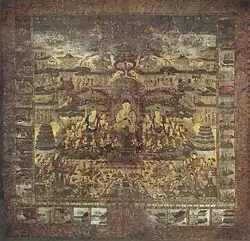Kengen (乾元) was a Japanese era name (年号, nengō; lit. "year name") after Shōan and before Kagen. This period spanned the years from November 1302 through August 1303.[1] The reigning emperor was Go-Nijō-tennō (後二条天皇).[2]
Change of era
- 1302 Kengen gannen (乾元元年): The new era name was created to mark an event or a number of events. The previous era ended and a new one commenced in Shōan 4. The era name is derived from the I Ching and combines the characters 乾 ("heaven" in the Bagua) and 元 ("foundation").
Events of the Kengen era
- 1302 (Kengen 1, 16th day of the 6th month):Emperor Go-Nijo visited the home of retired Emperor Kameyama.[3]
- 1302 (Kengen 1): Major repairs and reconstruction at Yakushi-ji.[4]
Notes
- ^ Nussbaum, Louis-Frédéric. (2005). "Kengen" in Japan Encyclopedia, p. 508, p. 508, at Google Books; n.b., Louis-Frédéric is pseudonym of Louis-Frédéric Nussbaum, see Deutsche Nationalbibliothek Authority File Archived 2012-05-24 at archive.today.
- ^ Titsingh, Isaac. (1834). Annales des empereurs du japon, p. 275-278; Varley, H. Paul. (1980). Jinnō Shōtōki. p. 239.
- ^ Perkins, George W. (1998). The Clear Mirror: a Chronicle of the Japanese Court During the Kamakura period (1185-1333), p. 150., p. 150., at Google Books
- ^ Pier, Garrett Chatfield. (1914). Temple treasures of Japan, p. 95., p. 95, at Google Books
References
External links
|
|---|
538–1264 |
|---|
| Asuka | Heian | Heian (cont'd) | Heian (cont'd) | Heian (cont'd) | Heian (cont'd) | Kamakura (cont'd) | | | | | | | |
|
|
|
|

